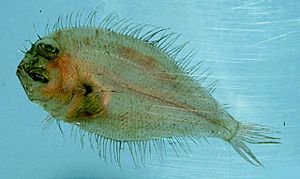Horned whiff facts for kids
Quick facts for kids Horned whiff |
|
|---|---|
 |
|
| Conservation status | |
| Scientific classification | |
| Synonyms | |
|
The horned whiff (Citharichthys cornutus) is a type of flatfish that lives in the ocean. It's part of a family called Paralichthyidae, also known as large-tooth flounders. This fish spends its life near the bottom of the sea, in both warm and mild waters of the western Atlantic Ocean.
Contents
About the Horned Whiff
The horned whiff is a demersal fish, which means it lives on or near the seafloor. You can find it on the continental shelves of the western Atlantic Ocean. Its home stretches from New Jersey in the north all the way down to Uruguay in the south. Sometimes, even tiny baby horned whiffs (called larvae) have been found off the coast of Canada.
This fish usually lives in deeper parts of the ocean. It can be found anywhere from about 30 meters (100 feet) to 400 meters (1,300 feet) deep.
What the Horned Whiff Looks Like
Like all large-tooth flounders, the horned whiff has both of its eyes on the left side of its head. It's a pretty small fish, growing to a maximum length of about 9.1 centimeters (3.6 inches). That's shorter than a typical smartphone!
The horned whiff looks a lot like two other types of flatfish: C. gymnorhinus and C. amblybregmatus. These three species often live in the same areas.
Interestingly, male and female horned whiffs look a bit different from each other. This is called sexual dimorphism. The males have special features that make them stand out.
Why This Fish Is Not Caught Much
Because the horned whiff is so small, it's not very important for fishing. There are many other, larger flatfish that people prefer to catch. This means that horned whiffs are rarely collected by humans.
Because of this, scientists don't know a lot about the horned whiff's body shape (its morphology) or how it lives in its environment (its ecology). What we do know comes from only a few samples that have been found.
- Froese, Rainer and Pauly, Daniel, eds. (2013). "Citharichthys cornutus" in FishBase. February 2013 version.
See also
 In Spanish: Citharichthys cornutus para niños
In Spanish: Citharichthys cornutus para niños


